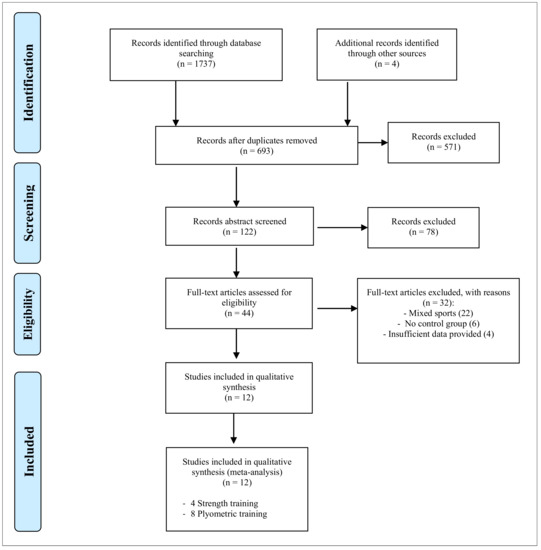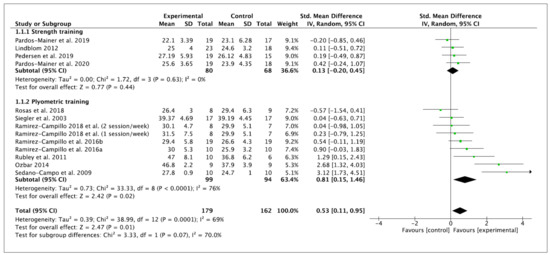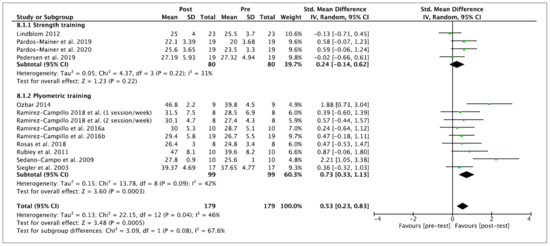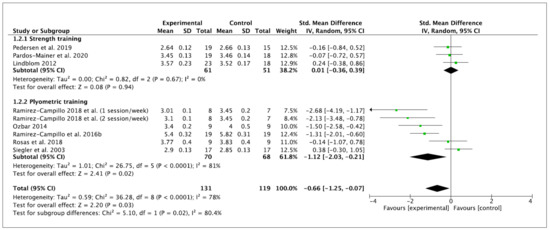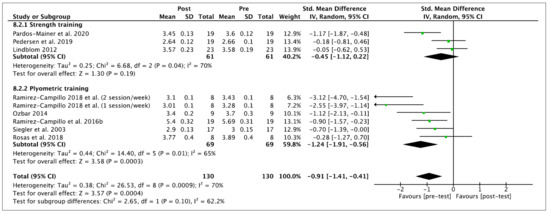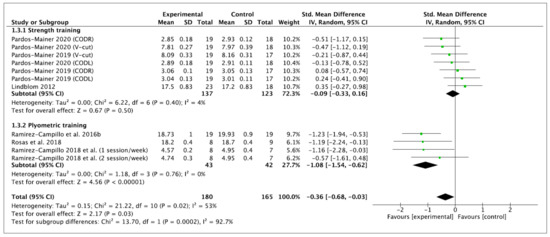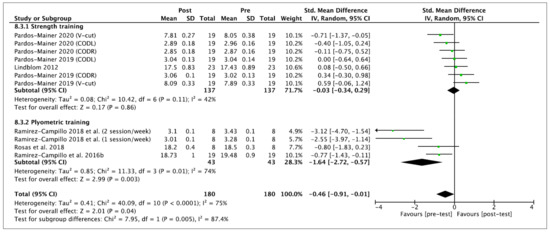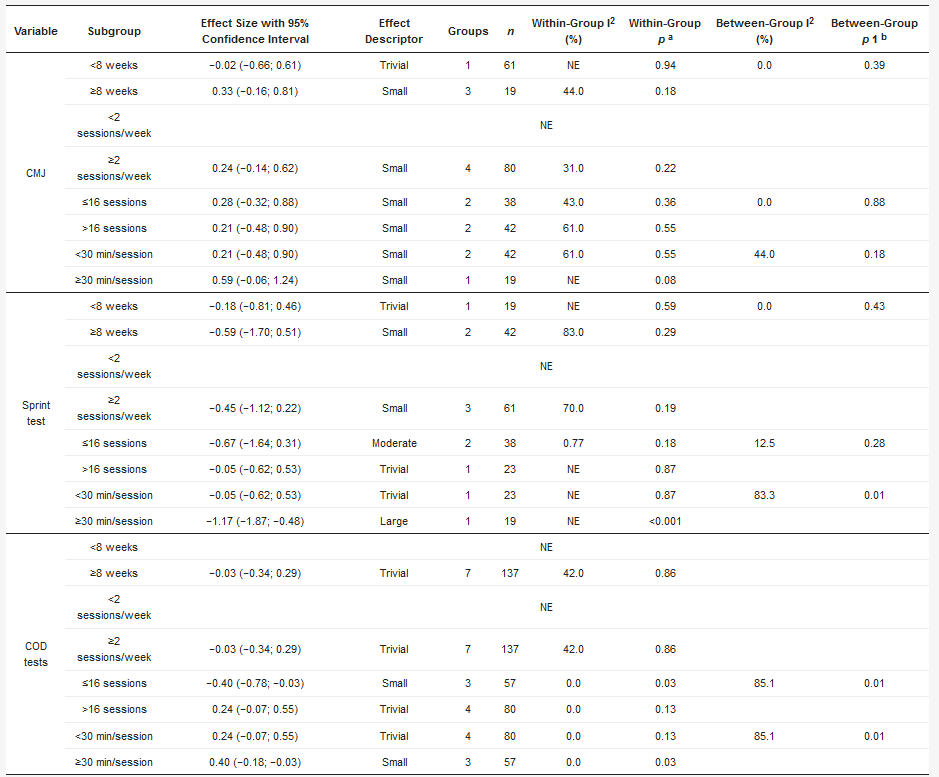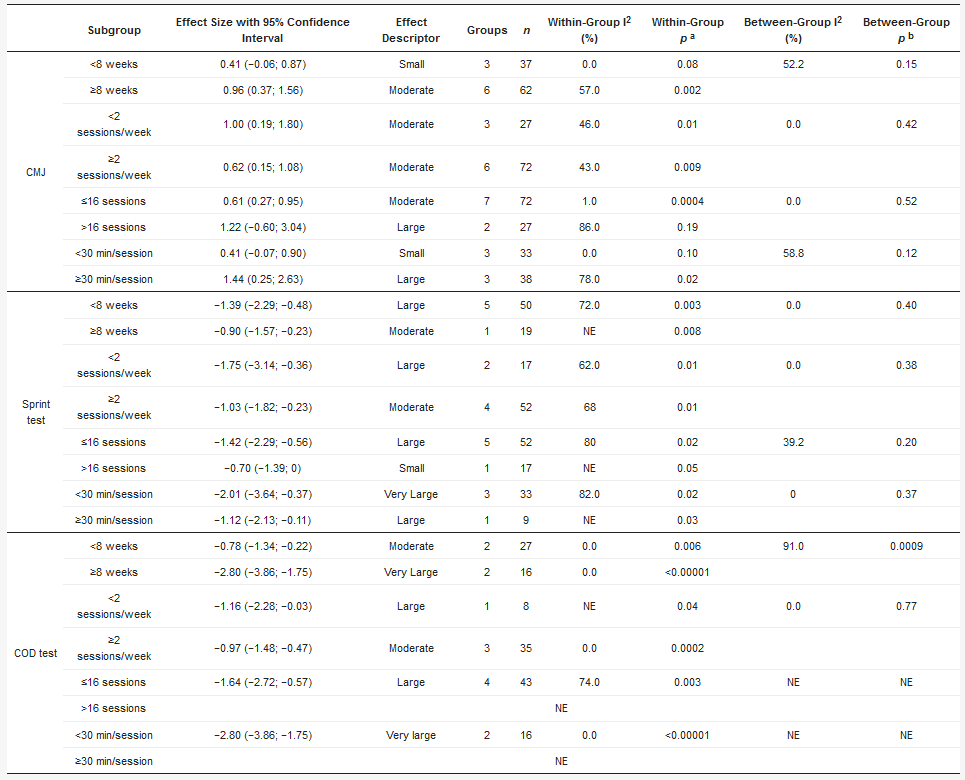Women’s soccer has increased in popularity and participation during the last decade. Soccer is considered a contact sport and such impact has had consequences through both a greater skill level and physical demands throughout training and matches. Some of the physical demands for female soccer players during matches have been reported, with total distances covered reaching 10 km, 1.7 km of which was completed at high speed (>18 km·h−1). In addition, female players perform between 1350 and 1650 changes of activity, such as passing, tackling, trapping and dribbling. Despite its growing popularity, female players are exposed to greater training volumes and competition demands than ever before and, therefore, a better understanding of female players’ physical performance changes is needed to design appropriate training programs.
1. Introduction
Different intervention programs, such as neuromuscular training, plyometric training (PT), strength training (ST) or power training [
5,
6,
7,
8], have been performed to improve physical capacities. However, there are discrepancies about which are the best exercises to improve female soccer players’ performance due to the lack of studies.
Plyometrics consists of the rapid stretching of a muscle (eccentric action) immediately followed by a concentric or shortening action of the same muscle and connective tissue [
9]. This training method is used to increase strength and explosiveness [
10] and it includes a diverse range of bilateral and unilateral jumps, bounds and hops [
9]. Regarding female soccer players, PT improves jumping, single and repeated sprinting, changes in direction and kicking power, as well as endurance attributes [
11]. Several reviews and meta-analyses related to PT programs have been published in soccer [
12,
13]. This program constitutes an efficient training solution to improve different power-related skills. However, this evidence has not been clarified in female soccer players, although it has increased the scientific value of PT regarding physical fitness enhancements [
12,
13]. Hence, more studies for this population are warranted.
Maximal strength is the maximum force or torque that can be exerted by skeletal muscles during movement [
14]. An ST program can contribute to improved vertical jump performance, acceleration, leg strength, muscular power, increased joint awareness and overall proprioception [
15]. However, intervention studies of ST regarding physical condition in female soccer players are lacking [
7]. Despite this, several reviews and meta-analyses related to ST programs have been published in different populations and sports [
16,
17,
18,
19]. Nevertheless, the improvement caused by ST raises certain doubts, since the authors do not agree on which doses and exercises are recommended to improve the strength of the lower extremities. In relation to this, research is necessary to provide coaches and practitioners with more information to plan their ST programs.
To our knowledge, there have been no reviews conducted regarding the effects of ST on female soccer players, particularly on physical fitness. Given that PT appears serve as a skill solution to meet the demands of female soccer, an investigation comparing the effects of both programs in female soccer players is warranted. Therefore, the main purpose of this systematic review and meta-analysis was to compare the effects of ST and PT on jump ability, linear sprint and change of direction (COD) performance in female soccer players. A secondary aim was to establish clear guidelines for the prescription of both types of training in female soccer players.
2. Literature Search
The US National Library of Medicine (PubMed), Web of Science, Google Scholar and SportDiscus electronic databases from inception until 19 October 2020 were searched. Only English and Spanish language articles were considered. Using Boolean logic, we used the following search terms: (“female”) AND (“soccer” OR “football”) AND (“intervention” OR “training”) AND (“strength” OR “plyometric” OR “jump” OR “strength” OR “power” OR “change of direction” OR “side-step” OR “side-cutting” OR “sprint” OR “agility”). In selecting studies for inclusion, a review of all relevant article titles within was conducted before an examination of article abstracts and, then, full published articles. Only peer-reviewed articles were included in the meta-analysis. The search process is outlined in . Following the formal systematic searches, additional hand searches were conducted.
Figure 1. PRISMA flow chart for inclusion and exclusion of studies.
4. Main Effect
4.1. Vertical Jump Performance
Twelve studies were included in this systematic review and meta-analysis. Vertical jump height was measured in centimeters. The performance of training programs was associated with a moderate and significant increase in vertical jump performance (ES 0.53 (95% CI—0.11, 0.95), Z = 2.47 (p = 0.01)). There was a significant level of between-study heterogeneity (I2 = 69% (p = 0.0001)). Concerning the subgroup analyses, non-significant performance improvements were observed after ST (ES 0.24 (95% CI −0.14, 0.62), Z = 1.23 (p = 0.22)). A significant difference was observed for PT (ES 0.73 (95% CI—0.33, 1.13), Z = 3.48 (p = 0.0005)). No significant differences among subgroups were observed (p = 0.07). Within-mode ESs were small and moderate (ST: ES 0.24 (95% CI −0.14, 0.62), Z = 1.23 (p = 0.22); PT: ES 0.73 (95% CI—0.33, 1.13), Z = 3.60 (p = 0.0003)), respectively. No significant differences among subgroups were observed (p = 0.08). These results are displayed in (ST vs. PT) and (baseline vs. follow-up).
Figure 2. Forest plot of between-mode effect sizes with 95% confidence intervals (CIs) in vertical jump performance (cm). IV: inverse variance method; SD: standard deviation; Std: standardized.
Figure 3. Forest plot of within-mode effect sizes with 95% confidence intervals (CIs) in vertical jump performance (cm). IV: inverse variance method; SD: standard deviation; Std: standardized.
4.2. Linear Sprint Time
Nine effects were analyzed from 12 original studies. The linear sprint performance was measured in time (seconds). The performance of training programs was associated with a moderate and significant reduction in the time of linear sprint (ES −0.66 (95% CI −2.03, −0.21), Z = 2.20 (p = 0.03)). There was a significant level of between-study heterogeneity (I2 = 78% (p = < 0.0001)). Concerning the subgroup analyses, non-significant performance improvements were observed after ST (ES 0.01 (95% CI −0.36, 0.39), Z = 0.08 (p = 0.94)). A significant difference was observed for PT (ES −1.12 (95% CI −2.03, 0.21), Z = 2.41 (p = 0.02)). Significant differences among subgroups were observed (p = 0.02). Within-mode ESs were small and large (ST: ES −0.45 (95% CI −1.12, 0.22), Z = 1.30 (p = 0.19); PT: ES −1.24 (95% CI −1.91, 0.56), Z = 3.58 (p = 0.0003)), respectively. No significant differences among subgroups were observed (p = 0.10). These results are displayed in (ST vs. PT) and (baseline vs. follow-up).
Figure 4. Forest plot of between-mode effect sizes with 95% confidence intervals (CIs) in time of linear sprint (s). IV: inverse variance method; SD: standard deviation; Std: standardized.
Figure 5. Forest plot of within-mode effect sizes with 95% confidence intervals (CIs) in time of linear sprint (s) e. IV: inverse variance method; SD: standard deviation; Std: standardized.
4.3. COD Time
Seven effects were analyzed from 12 original studies. The COD performance was measured in time (seconds). The performance of training programs was associated with a small and significant reduction in the time of COD (ES −0.36 (95% CI −0.68, −0.03), Z = 2.17 (p = 0.03)). There was a significant level of between-study heterogeneity (I2 = 53% (p = 0.02)). Concerning the subgroup analyses, non-significant performance improvements were observed after ST (ES −0.09 (95% CI −0.33, 0.16), Z = 0.67 (p = 0.50)). A significant difference was observed for PT (ES −1.08 (95% CI −1.54, −0.62), Z = 2.17 (p = 0.03)). Significant differences among subgroups were observed (p = 0.0002). Within-mode ESs were small and large (ST: ES −0.03 (95% CI −0.34, 0.29), Z = 0.17 (p = 0.86); PT: ES −1.64 (95% CI −2.72, 0.57), Z = 2.99 (p = 0.003)), respectively. Significant differences among subgroups were observed (p = 0.005). These results are displayed in (ST vs. PT) and (baseline vs. follow-up).
Figure 6. Forest plot of between-mode effect sizes with 95% confidence intervals (CIs) in the time of change of direction (s). IV: inverse variance method; SD: standard deviation; Std: standardized.
Figure 7. Forest plot of within-mode effect sizes with 95% confidence intervals (CIs) in the time of change of direction (s). IV: inverse variance method; SD: standard deviation; Std: standardized.
3.5. Effect of Moderator Variables
A summary of the effect of moderator variables can be viewed in and .
Table 4. Effect of moderator variables with 95% confidence intervals in strength training.
Table 5. Effect of moderator variables with 95% confidence intervals in plyometric training.
4.6. Strength Training
Subgroup analysis suggested high levels of between-group heterogeneity with session duration in linear sprint performance and total number of training session and session duration in COD performance, achieving statistical significance (p = 0.01).
Differences were trivial to small between each training type across subgroups in vertical jump and COD performance and trivial to large in linear sprint performance. In linear sprint performance, interventions with a total number of training sessions of less than 16 sessions produced moderate effects (ES −0.67 (95%CI = −1.64; 0.31), Z = 1.34 (p = 0.18)) compared to those that lasted longer than 16 sessions (ES −0.05 (95%CI = −0.62; 0.53), Z = 0.16 (p = 0.87)). Sessions that lasted longer than 30 min were substantially more effective (ES −1.17 (95%CI = −1.87; −0,48), Z = 3.31 (p = 0.0009)) than those that lasted less than 30 min (ES −0.05 (95%CI = −0.62; 0.53)), Z = 0.16 (p = 0.87)). In COD performance, interventions with a total number of training sessions of less than 16 sessions produced smaller effects (ES −0.40 (95%CI = −0.78; −0.03), Z = 2.12 (p = 0.03)) than those that lasted longer than 16 sessions (ES 0.24 (95%CI = −0.07; 0.55), Z = 1.51 (p = 0.13)). Sessions that lasted longer than 30 min were substantially more effective (ES −0.40 (95%CI = −0.78; 0.03), Z = 2.12 (p = 0.03)) than those that lasted less than 30 min (ES 0.24 (95%CI = −0.07; 0.55), Z = 1.51 (p = 0.13)). In vertical jump and COD performance, the level of heterogeneity was higher in subgroups with longer programs, greater training frequency, more training sessions and fewer minutes per session. In linear sprint performance, levels of heterogeneity were higher in subgroups with longer programs, greater training frequency and fewer training sessions.
4.7. Plyometric Training
Subgroup analysis suggested high levels of between-group heterogeneity, with program duration in COD performance achieving statistical significance (p < 0.001). Differences were small to large in vertical jump, trivial to very large in linear sprint and moderate to very large in COD performance. All subgroup variables in linear sprint and COD performance demonstrated a significant effect. In vertical jump performance, only interventions with a total number of training sessions of more than 16 sessions (ES −1.22 (95%CI = −0.60; 3.04), Z = 1.32 (p = 0.19)) and which lasted less than 30 min (ES 0.41 (95%CI = −0.07; 0.90), Z = 1.66 (p = 0.10)) did not demonstrate a significant effect. In vertical jump performance, the level of heterogeneity was higher in subgroups with shorter programs, lower training frequency and more training sessions and minutes per session. In linear sprint performance, levels of heterogeneity were higher in subgroups with shorter programs, greater training frequency, fewer training sessions and fewer minutes per session. The level of heterogeneity in COD performance was higher in subgroups with fewer training sessions.
5. Conclusions
The findings of this systematic review and meta-analysis suggest that PT seems to provide better benefits than ST to improve vertical jump, linear sprint and COD performance in female soccer players. However, significant limitations in the current literature prevent assured PT and ST prescriptions recommendations being made. Based on our results, it seems that theses physical performance gains may be optimized by the use of vertical, horizontal and unilateral jumps at high speed and these exercises represent a natural part of the majority of sport movement because they involve jumping, hopping and skipping. In addition, exercises included in ST were generally carried out at slow speeds and could decrease the performance. Further research is needed in adolescent, recreational, elite and adult female soccer players to investigate the effects of PT and ST on performance. Furthermore, longer-term studies are also needed to determine and compare the long-term effectiveness of both training programs on performance.
This entry is adapted from the peer-reviewed paper 10.3390/ijerph18020401
